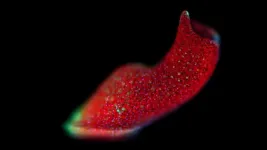(Press-News.org) The human papillomavirus (HPV) vaccination programme in England has not only been associated with a substantial reduction in cervical disease, but has done so in all socioeconomic groups, finds a study published by The BMJ today.
Although women living in the most deprived areas are still at higher risk of cervical disease than those in less deprived areas, the results show that well planned and executed public health interventions can both improve health and reduce health inequalities.
HPV is one of the most common sexually transmitted infections. Many countries, including the UK, now offer routine vaccination to girls and boys at age 12-13 to protect them against strains that can cause cancer in later life.
In England, the HPV vaccination programme began in 2008, with catch-up vaccination for 14-18 year olds from 2008-10. But because cervical cancer rates have always been higher in the most deprived groups, there is concern that HPV vaccination could benefit those at greatest risk of cervical cancer the least.
To address this, researchers analysed cancer data from NHS England for vaccinated and unvaccinated women aged 20-64 years resident in England between January 2006 and June 2020 to examine if the already high HPV vaccination effectiveness continued in an additional year of follow-up, from July 2019 - June 2020.
And they used the index of multiple deprivation, which divides local areas into five equal groups from the most to the least deprived, to assess the effect of the vaccination programme by social and economic deprivation.
Between 1 January 2006 and 30 June 2020 there were 29,968 diagnoses of cervical cancer and 335,228 of grade 3 precancerous cervical lesions (CIN3) in women aged 20-64 years.
In the group of women offered vaccination at age 12-13, rates of cervical cancer and CIN3 in the additional year of follow-up were, respectively, 84% and 94% lower than in the older unvaccinated group.
Overall, the researchers estimate that by mid-2020, HPV vaccination had prevented 687 cancers and 23,192 CIN3s.
The highest rates remained among women living in the most deprived areas, but the HPV vaccination programme had a large effect in all five levels of deprivation.
For example, the greatest numbers of cervical cancer cases were prevented in women in the most deprived areas (192 and 199 for first and second fifths, respectively) and the fewest in women in the least deprived fifth (61 cancers prevented).
The number of women with CIN3 prevented was also high across all deprivation groups but greatest among women living in the more deprived areas: 5,121 and 5,773 for first and second fifths, respectively, compared with 4,173 and 3,309 in the fourth and fifth fifths, respectively.
For women offered catch-up vaccination at age 14-18, CIN3 rates decreased more in those from the least deprived areas than from the most deprived areas. However, for cervical cancer, the strong downward gradient from high to low deprivation seen in the older unvaccinated cohort was no longer present among those offered the vaccine.
This is an observational study so no firm conclusions can be drawn about cause and effect, and individual-level data on vaccination status were not available. However, randomised controlled trials have shown conclusively that the vaccine works in preventing HPV infection and in preventing CIN3 in women free of HPV at the time of vaccination.
What’s more, the authors say this was a well designed study based on high-quality population-based cancer registry data, making it “powerful and less prone to biases from unobserved confounders than an analysis based on individual-level data on HPV vaccination status.”
As such, they conclude: “The HPV vaccination programme in England has not only been associated with a substantial reduction in incidence of cervical neoplasia in targeted cohorts, but also in all socioeconomic groups.”
They add: “Cervical screening strategies for women offered vaccination should carefully consider the differential effect both on rates of disease and on inequalities that are evident among women offered catch-up vaccination.”
The HPV vaccine is key to eliminating cervical cancer inequities, say US researchers in a linked editorial.
They point to the importance of attaining the 90% coverage target recommended by the World Health Organization, but acknowledge several challenges such as vaccine hesitancy, finances, health system capacity, supply, and variation in the extent to which healthcare providers recommend vaccination.
To overcome the challenges of reaching target coverage and to maximize population herd immunity, “collective efforts of government, community stakeholders, and healthcare professionals in these countries will be necessary,” they conclude.
[Ends]
END
New study shows continued high effectiveness of HPV vaccination in England
Substantially reduced rates seen across all socioeconomic groups
2024-05-16
ELSE PRESS RELEASES FROM THIS DATE:
HPV vaccine prevents most cervical cancer cases in more deprived groups, major study shows
2024-05-16
Strict embargo: 23.30 hrs BST
Wednesday, 15 May, 2024
Peer-reviewed
Observational
People
The human papillomavirus, or HPV, vaccine is cutting cases of cervical cancer right across the socio-economic spectrum, with most cases being prevented in more deprived groups, according to a major study funded by Cancer Research UK.
Until now, there had been concerns that the HPV vaccine could have an unequal impact across society. After carrying out the longest follow-up on the effectiveness of the HPV vaccine, researchers at Queen Mary University of London concluded the HPV vaccination programme in England is helping to close some inequalities ...
Radiation-based immunogenic vaccine combined with a macrophage “checkpoint inhibitor” for boosting innate and adaptive immunity against metastatic colon cancers
2024-05-15
https://doi.org/10.1016/j.apsb.2024.02.015
This new article publication from Acta Pharmaceutica Sinica B, discusses how the use of a radiation-based immunogenic vaccine combined with a macrophage “checkpoint inhibitor” can boost innate and adaptive immunity against metastatic colon cancers.
Immunogenic dying tumor cells hold promising prospects as cancer vaccines to activate systemic immunity against both primary and metastatic tumors. Especially, X-ray- induced dying tumor cells are rich in highly immunogenic tumor-associated antigens ...
Branched glycopolymer prodrug-derived nanoassembly combined with a STING agonist activates an immuno-supportive status to boost anti-PD-L1 antibody therapy
2024-05-15
https://doi.org/10.1016/j.apsb.2024.02.006
This new article publication from Acta Pharmaceutica Sinica B, discusses how branched glycopolymer prodrug-derived nanoassembly combined with a STING agonist activates an immuno-supportive status to boost anti-PD-L1 antibody therapy.
Despite the great potential of anti-PD-L1 antibodies for immunotherapy, their low response rate due to an immunosuppressive tumor microenvironment has hampered their application.
To address this issue, the authors of this article constructed a cell membrane-coated nanosystem (mB4S) to reverse an immunosuppressive microenvironment to an immuno-supportive ...
5S-Heudelotinone alleviates experimental colitis by shaping the immune system and enhancing the intestinal barrier in a gut microbiota-dependent manner
2024-05-15
https://doi.org/10.1016/j.apsb.2024.02.020
This new article publication from Acta Pharmaceutica Sinica B, discusses how 5S-Heudelotinone alleviates experimental colitis by shaping the immune system and enhancing the intestinal barrier in a gut microbiota-dependent manner.
Aberrant changes in the gut microbiota are implicated in many diseases, including inflammatory bowel disease (IBD). Gut microbes produce diverse metabolites that can shape the immune system and impact the intestinal barrier integrity, indicating that microbe-mediated modulation may be a promising strategy for preventing and treating IBD.
Although ...
ALS-linked C9orf72 dipeptide repeats inhibit starvation-induced autophagy through modulating BCL2–BECN1 interaction
2024-05-15
https://doi.org/10.1016/j.apsb.2024.02.004
This new article publication from Acta Pharmaceutica Sinica B, discusses how ALS-linked C9orf72 dipeptide repeats inhibit starvation-induced autophagy through modulating BCL2–BECN1 interaction.
Growing evidence indicate that dysfunction of autophagy contributes to the disease pathogenesis of amyotrophic lateral sclerosis (ALS) and frontotemporal dementia (FTD), two neurodegenerative disorders. The GGGGCC·GGCCCC repeat RNA expansion in chromosome 9 open reading frame 72 (C9orf72) ...
Carbon-capture batteries developed to store renewable energy, help climate
2024-05-15
Researchers at the Department of Energy’s Oak Ridge National Laboratory are developing battery technologies to fight climate change in two ways, by expanding the use of renewable energy and capturing airborne carbon dioxide.
This type of battery stores the renewable energy generated by solar panels or wind turbines. Utilizing this energy when wind and sunlight are unavailable requires an electrochemical reaction that, in ORNL’s new battery formulation, captures carbon dioxide from industrial emissions and converts it to value-added products.
ORNL researchers recently created and tested two different formulations for batteries that ...
From roots to resilience: investigating the vital role of microbes in coastal plant health
2024-05-15
Georgia’s saltwater marshes — living where the land meets the ocean — stretch along the state’s entire 100-mile coastline. These rich ecosystems are largely dominated by just one plant: grass.
Known as cordgrass, the plant is an ecosystem engineer, providing habitats for wildlife, naturally cleaning water as it moves from inland to the sea, and holding the shoreline together so it doesn’t collapse. Cordgrass even protects human communities from tidal surges.
Understanding how these ...
Q&A: How did the COVID-19 pandemic affect older adults’ technology use?
2024-05-15
The onset of the COVID-19 pandemic changed how nearly everyone mediated their social interactions through technology. Some moved happy hours into video chats. Others delved deeper into social media, or took a step back from it. Millions of people worked or learned through computers.
University of Washington researchers took particular interest in how this tech shift affected older adults’ social relationships. The team interviewed 16 older adults in Washington and Oregon, ages 65 to 80, about how their technology ...
Blood pressure drugs more than double bone-fracture risk in nursing home patients
2024-05-15
Records from nearly 30,000 nursing home residents indicate that blood pressure medications more than double the risk of life-threatening bone fractures, according to Rutgers Health research.
The authors of the study, which appears in JAMA Internal Medicine, said the increased risk stems from the medications’ tendency to impair balance, particularly when patients first stand up and temporarily experience low blood pressure that deprives the brain of oxygen. Interactions with other drugs and low baseline balance in many nursing home patients compound the problem.
“Bone fractures often start nursing home patients on a downward spiral,” ...
Regenerating worms have genetic control over their algal partners
2024-05-15
Many organisms are far more complex than just a single species. Humans, for example, are full of a variety of microbes. Some creatures have even more special connections, though. Acoels, unique marine worms that regenerate their bodies after injury, can form symbiotic relationships with photosynthetic algae that live inside them. These collections of symbiotic organisms are called a holobiont, and the ways that they “talk” to each other are something scientists are trying to understand – especially ...
LAST 30 PRESS RELEASES:
Eye for trouble: Automated counting for chromosome issues under the microscope
The vast majority of US rivers lack any protections from human activities, new research finds
Ultrasound-responsive in situ antigen "nanocatchers" open a new paradigm for personalized tumor immunotherapy
Environmental “superbugs” in our rivers and soils: new one health review warns of growing antimicrobial resistance crisis
Triple threat in greenhouse farming: how heavy metals, microplastics, and antibiotic resistance genes unite to challenge sustainable food production
Earthworms turn manure into a powerful tool against antibiotic resistance
AI turns water into an early warning network for hidden biological pollutants
Hidden hotspots on “green” plastics: biodegradable and conventional plastics shape very different antibiotic resistance risks in river microbiomes
Engineered biochar enzyme system clears toxic phenolic acids and restores pepper seed germination in continuous cropping soils
Retail therapy fail? Online shopping linked to stress, says study
How well-meaning allies can increase stress for marginalized people
Commercially viable biomanufacturing: designer yeast turns sugar into lucrative chemical 3-HP
Control valve discovered in gut’s plumbing system
George Mason University leads phase 2 clinical trial for pill to help maintain weight loss after GLP-1s
Hop to it: research from Shedd Aquarium tracks conch movement to set new conservation guidance
Weight loss drugs and bariatric surgery improve the body’s fat ‘balance:’ study
The Age of Fishes began with mass death
TB harnesses part of immune defense system to cause infection
Important new source of oxidation in the atmosphere found
A tug-of-war explains a decades-old question about how bacteria swim
Strengthened immune defense against cancer
Engineering the development of the pancreas
The Journal of Nuclear Medicine ahead-of-print tip sheet: Jan. 9, 2026
Mount Sinai researchers help create largest immune cell atlas of bone marrow in multiple myeloma patients
Why it is so hard to get started on an unpleasant task: Scientists identify a “motivation brake”
Body composition changes after bariatric surgery or treatment with GLP-1 receptor agonists
Targeted regulation of abortion providers laws and pregnancies conceived through fertility treatment
Press registration is now open for the 2026 ACMG Annual Clinical Genetics Meeting
Understanding sex-based differences and the role of bone morphogenetic protein signaling in Alzheimer’s disease
Breakthrough in thin-film electrolytes pushes solid oxide fuel cells forward
[Press-News.org] New study shows continued high effectiveness of HPV vaccination in EnglandSubstantially reduced rates seen across all socioeconomic groups


